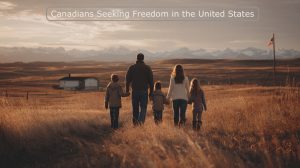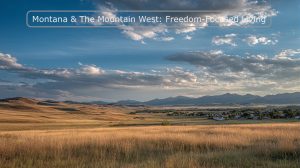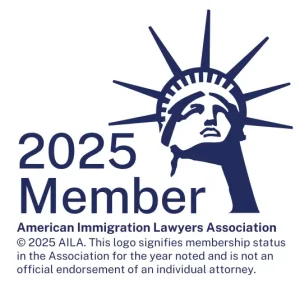For Canadians who felt the weight of government overreach during COVID-19 and are seeking greater freedom in America
The COVID-19 pandemic was a turning point for many Canadians. As governments implemented increasingly restrictive policies—prolonged lockdowns, strict travel restrictions, vaccine mandates, frozen bank accounts during protests, and invocation of emergency powers—many Canadians began questioning the balance between public health and civil liberties.
For the first time, significant numbers of Canadians looked south and saw a fundamentally different approach. While Canada maintained some of the strictest and longest-lasting restrictions in the developed world, many U.S. states took dramatically different paths, prioritizing individual liberty and economic freedom.
If you’re a Canadian who felt persecuted by your government’s COVID response—or who continues to feel concerned about government overreach in areas like resource development, free speech, or economic freedom—you’re not alone. We’ve worked with many Canadians since 2020 who share these concerns and successfully helped them build new lives in the United States.
The Legal Reality: Why “Asylum” Doesn’t Apply (But You’re Actually Better Off)
Understanding U.S. Asylum Law
When you read about asylum seekers or refugees entering the United States, it’s natural to think: “I feel persecuted by my government too. Can I claim asylum?”
The legal answer is no—but that’s actually good news for you.
U.S. asylum law requires persecution based on one of five specific grounds:
- Race
- Religion
- Nationality
- Political opinion
- Membership in a particular social group
Government policies regarding:
- COVID-19 restrictions and vaccine mandates
- Resource industry regulation (oil, gas, mining)
- Economic policies and taxation
- General political disagreements
- Civil liberty concerns
These don’t meet the legal definition of persecution under U.S. asylum law, regardless of how strongly you felt the impact or how unjust the policies seemed.
Why You’re Actually in a Better Position
Here’s the crucial point: You’re not seeking asylum because you don’t need to. Unlike true asylum seekers who often arrive with nothing but the clothes on their backs, most Canadians have significant advantages:
You Have Resources:
- Home equity from Canada’s strong housing market
- Business experience and capital
- Professional skills and education
- Retirement savings and investments
- The ability to plan strategically rather than flee desperately
You Have Better Options:
- Multiple legal immigration pathways available
- Ability to maintain Canadian ties while establishing U.S. presence
- Freedom to visit, evaluate, and choose where to settle
- Time to plan the optimal strategy for your family
You Get Better Outcomes:
- More secure legal status than asylum
- Faster paths to permanent residency
- Ability to include entire family
- No years-long wait in legal limbo
- Professional opportunities available immediately
The Canadians we’ve helped “escape” to the United States have done so through legitimate immigration channels that provide more security, more opportunities, and better outcomes than asylum ever could.
Five Legal Pathways to U.S. Immigration for Canadians
1. Derivative Citizenship: You Might Already Be a U.S. Citizen
Before exploring other options, we always check whether you might already be a U.S. citizen without knowing it. This is surprisingly common for Canadians.
You might have U.S. citizenship if:
- One or both parents were U.S. citizens when you were born
- A parent naturalized as a U.S. citizen while you were a minor
- Your grandparents were U.S. citizens (in some circumstances)
Why this matters for “freedom seekers”: If you’re already a U.S. citizen, you can simply move to the United States immediately. No visa, no immigration process, no waiting. You just need to prove your citizenship and obtain a U.S. passport.For official requirements, consult the USCIS Policy Manual on derivative citizenship.
Simple vs. Complex Cases:
Some derivative citizenship cases are straightforward and can be handled through the Calgary consulate with clear documentation. Others require legal expertise to gather evidence, interpret complex laws, or overcome previous denials.
We’ve successfully established U.S. citizenship for Canadians who had no idea they qualified. This is always our first analysis because it’s the fastest, least expensive path to living in the United States.
Learn more about derivative citizenship for Canadians.
2. Marriage to a U.S. Citizen: Family Reunification
If you’re married to (or planning to marry) a U.S. citizen, you have one of the most straightforward paths to permanent U.S. residency.
Why this works for freedom seekers: Marriage-based green cards provide immediate permanent residency—not temporary status. You can live, work, and establish your life in the United States with full legal protection.
Your options depend on your situation:
Already Married:
- Consular processing if you’re in Canada (apply through U.S. consulate)
- Adjustment of status if you’re already in the United States
- Timeline: typically 12-18 months to green card
Planning to Marry:
- K-1 fiancé visa allows you to enter the U.S. to marry
- Marry within 90 days, then adjust status to permanent resident
- Timeline: varies but often faster than consular processing
Strategic Considerations:
For Canadians concerned about government overreach, marriage-based immigration offers:
- Permanent residency (not temporary visa requiring renewals)
- Path to U.S. citizenship after 3 years
- Full work authorization
- Ability to sponsor other family members later
- Freedom from ongoing immigration status concerns
Many Canadians who felt uncomfortable with their government’s direction have successfully built new lives in the United States through marriage to American citizens (including dual Canadian-U.S. citizens who chose to live in America).
Learn more about marriage-based green cards and K-1 fiancé visas.
3. Employment-Based Immigration: Using Your Professional Skills
If you have marketable professional skills, employment-based immigration can provide a direct path to permanent U.S. residency.
Why this works for freedom seekers: You’re not dependent on government programs or temporary visas. A U.S. employer sponsors you for permanent residency based on your value as an employee—a purely economic transaction that provides secure legal status.
How Employment-Based Green Cards Work:
Unlike temporary work visas, employment-based green cards lead directly to permanent residency. The process typically involves:
- S. employer identifies need for your specific skills
- Labor certification (proving no qualified U.S. workers available)
- I-140 immigrant petition filed by employer
- Green card application leading to permanent residency
The Challenge: Getting Your Foot in the Door
Here’s the reality: U.S. employers typically won’t sponsor unknown foreign workers for expensive green card processes. The sponsorship can cost $20,000+ and takes 1-3 years.
But here’s the strategy many successful Canadians use:
Step 1: Enter the U.S. on a temporary work visa
- TN visa (NAFTA professional)
- H-1B visa (specialty occupation)
- L-1 visa (intracompany transfer)
- Or as an E-2 spouse with work authorization (see below)
Step 2: Prove your value to the employer
- Demonstrate you’re productive beyond your salary
- Become essential to the company’s operations
- Build relationships and show commitment
Step 3: Employer sponsors you for green card
- Once you’ve proven your value, employers are willing to invest
- Typical quid pro quo: employer pays for green card, you commit to 2-3 years post-approval
- Entire family gets permanent residency
This strategy has worked for many Canadians who wanted to leave Canada but had marketable skills rather than investment capital.
Best Fields for Employment-Based Immigration:
- Technology and IT
- Healthcare (doctors, nurses, therapists)
- Engineering
- Skilled trades (with proper credentials)
- Management and executive positions
Learn more about employment-based green cards and work visa options.
4. E-2 Treaty Investor Visa: Business Investment Path
For Canadians with business experience and investment capital, theE-2 treaty investor visa provides an excellent pathway to living and working in the United States.
Why this works for freedom seekers:
The E-2 visa gives you freedom and flexibility that asylum never could:
- No minimum time in the U.S. (unlike green card residency requirements)
- Operate business from Canada if structured properly
- Cross-border flexibility for business operations
- Spouse can work anywhere in the U.S. (full work authorization)
- Renewable indefinitely as long as business continues
- No dealing with CBP suspicion (established legal status eliminates border interrogations)
Investment Requirements:
There’s no fixed minimum, but successful E-2 applications typically involve:
- $100,000-$200,000+ for most small businesses
- Substantial relative to total business cost
- Active business requiring your development and direction (not passive investment)
- More than marginal (generates more than living for you and family)
Real Canadian Examples:
We’ve successfully obtained E-2 visas for Canadians:
- Starting trucking operations in Montana/North Dakota
- Purchasing coin-operated laundry businesses
- Establishing custom combining operations across the border
- Opening contracting and home building companies
- Investing in various service businesses
E-2 as “Freedom Insurance”:
One of our Calgary clients obtained an E-2 visa primarily for “freedom insurance.” He told us the visa was worth the investment just for hassle-free border crossings. Instead of CBP questioning his frequent U.S. visits and business activities, his E-2 status pre-cleared him as a legitimate business person. The peace of mind alone was worth it.
Strategic Considerations:
For Canadians concerned about government direction:
- Provides immediate legal presence in the U.S.
- Doesn’t require abandoning Canadian residence or business ties
- Offers testing ground for U.S. life before full commitment
- Can lead to other pathways (spouse employment to green card, EB-5 if business grows)
Family Benefits:
- Spouse receives work authorization (can work for any U.S. employer)
- Children can attend U.S. schools
- Strategic use: spouse uses work authorization to get sponsored for employment-based green card, benefiting entire family
Learn more about E-2 treaty investor visas and E-2 employee and family options.
5. EB-5 Investment Immigration: Direct Path to Permanent Residency
For wealthy Canadians who want permanent U.S. residency immediately, the EB-5 investor immigrant visa provides a direct path to green cards for the entire family.
Why this works for freedom seekers:
Unlike E-2 (temporary) or employment-based immigration (requires employer), EB-5 gives you:
- Immediate permanent residency for you and your family
- No employer required (you’re creating jobs, not working for someone)
- Path to citizenship after 5 years (3 years if married to U.S. citizen)
- Complete freedom to live and work anywhere in the United States
- Security that no policy changes can affect your status
Investment Requirements (2025):
- $900,000 in Targeted Employment Area (TEA) – rural or high unemployment areas
- $1,800,000 in non-TEA (standard investment)
- Must create or preserve 10 full-time jobs for U.S. workers
Who Can Afford This?
This is a realistic option for many successful Canadians who:
- Sold homes during Canada’s real estate boom (many Canadian properties appreciated significantly)
- Sold businesses or professional practices
- Have accumulated wealth from resource industries (oil, gas, mining)
- Have family wealth or inheritance
- Are liquidating Canadian assets to relocate
Why EB-5 Makes Sense for Freedom Seekers:
If you’ve decided you want to leave Canada permanently and have the resources, EB-5 provides:
- Immediate exit from Canadian government jurisdiction
- Permanent U.S. residency without temporary visa uncertainty
- Ability to bring entire family (spouse and unmarried children under 21)
- Freedom to live anywhere in the United States
- Potential to recoup investment after 5 years (depends on project structure)
The Montana/EB-5 Connection:
Montana and surrounding states offer EB-5 opportunities that may qualify for the lower $900,000 investment threshold as Targeted Employment Areas. Projects can include:
- Real estate development in rural areas
- Agricultural operations
- Manufacturing facilities
- Tourism and hospitality ventures
- Regional center investments (professionally managed)
Strategic Considerations:
EB-5 is the most expensive option, but for Canadians who:
- Have already decided to leave Canada permanently
- Have liquidity from selling Canadian assets
- Want immediate permanent status (not temporary visa)
- Value security over preserving all capital
This can be the most direct path to the freedom and security they’re seeking.
EB-5 Timeline:
- Application to conditional green card: 12-24 months
- Conditional status: 2 years (must show job creation)
- Remove conditions: become permanent resident
- Eligible for citizenship: 5 years from green card
Learn more about EB-5 investor immigration.
Understanding Your Exit Options from Canada
Tax and Asset Planning
Before moving to the United States, understand Canada’s exit tax requirements:
Deemed Disposition Rules: When you become a U.S. resident for tax purposes, Canada treats you as having sold all assets at fair market value. This triggers capital gains taxes on:
- Real estate (except principal residence)
- Business assets
- Investment portfolios
- RRSPs/RRIFs (special rules apply)
Strategic Planning: Work with cross-border tax advisors who understand both Canadian and U.S. tax law. Proper planning can:
- Minimize tax impact of departure
- Structure asset transfers optimally
- Coordinate with immigration timing
- Preserve retirement savings where possible
Maintaining Canadian Ties
Most Canadians don’t want to completely abandon Canada. Good news: most U.S. immigration options allow you to maintain Canadian ties:
You Can Keep:
- Canadian citizenship (Canada allows dual citizenship)
- Canadian property (though tax implications exist)
- Canadian bank accounts and investments
- TFSA, RRSP (with U.S. tax reporting)
- Healthcare coverage (varies by province, typically 6-month limit)
Strategic Considerations:
- E-2 visa: Great flexibility for maintaining Canadian base
- Green card: Requires physical presence in U.S. (risk abandonment if away too long)
- S. citizenship: Once naturalized, even more flexibility for travel
Why Location Matters: Montana and the Mountain West
Geographic Proximity
For Alberta, British Columbia, and Saskatchewan residents, Montana and surrounding states offer:
- Shorter distances than relocating to Toronto or Vancouver
- Similar climate and geography (especially Alberta-Montana)
- Cultural similarities (Western values, resource-based economies, independent mindset)
- Easier family visits (drive across border vs. fly across Canada)
Political and Economic Climate
The Mountain West states (Montana, Wyoming, North Dakota, South Dakota, Idaho) offer what many freedom-seeking Canadians are looking for:
- Strong property rights protection
- Lower taxes and less regulation
- Respect for individual liberty
- Resource-friendly economies (energy, mining, agriculture)
- Constitutional carry and Second Amendment protections
- State governments skeptical of federal overreach
Business Opportunities
For E-2 investors, the region offers:
- Lower business costs than coastal areas
- Labor availability for businesses creating jobs
- Resource sector opportunities (energy, mining, agriculture)
- Tourism and hospitality (Yellowstone, Glacier, ski areas)
- Service businesses (contractors, trucking, professional services)
Common Questions and Concerns
“Can I work while my immigration is pending?”
It depends on your pathway:
- E-2 visa: You can work in your business immediately upon approval
- E-2 spouse: Can work anywhere with work authorization
- K-1 fiancé: Must wait until after marriage and work authorization approval
- Employment-based: Depends on current status (TN, H-1B, L-1, etc.)
- EB-5: Can work immediately upon green card approval
“How long does it take?”
Timeline varies by pathway:
- Derivative citizenship: Can be immediate once proven (or months if complex)
- Marriage green card: 12-18 months typically
- E-2 visa: 2-4 months for Canadian applicants
- Employment green card: 1-3 years depending on category and country
- EB-5: 12-24 months to conditional green card
“What if my spouse/children don’t want to leave Canada?”
This is common. Options include:
- E-2 strategy: You get E-2, family can visit but maintain Canadian base
- Test period: Live in U.S. part-time initially
- Dual residence: Maintain homes in both countries (if status allows)
- Family decision point: Some families split time between countries
Many families start with flexible arrangements and make final decisions after experiencing U.S. life firsthand.
“Can I still get Canadian healthcare?”
Generally no, not as primary coverage:
- Most provinces require 6+ months physical presence annually
- Once U.S. resident, typically lose Canadian provincial coverage
- Must obtain U.S. health insurance
- Medicare available after 5 years permanent residency (if 65+)
This is a significant consideration in planning your move.
“What about my firearms?”
This is often important to freedom-seeking Canadians:
- Cannot bring most restricted/prohibited Canadian firearms to U.S.
- Can bring non-restricted firearms with proper ATF permits
- But: Easier and cheaper to buy in U.S. under U.S. law
- Second Amendment protections much stronger in U.S.
- Montana/Mountain West: Constitutional carry, strong gun rights
Most Canadian gun owners find U.S. firearms laws refreshingly permissive compared to Canada’s increasingly restrictive regulations.
“Will this affect my Canadian citizenship?”
No. Canada allows dual citizenship. Moving to the U.S. and even becoming a U.S. citizen doesn’t affect your Canadian citizenship unless you actively renounce it.
Strategic Planning for Your Freedom Move
Step 1: Assess Your Options
Every Canadian’s situation is unique. Start by determining:
- Derivative citizenship? Check this first—it’s free if you qualify
- Marriage option? If married to or seriously dating a U.S. citizen
- Professional skills? Could lead to employment-based green card
- Investment capital? E-2 ($100K-200K) or EB-5 ($900K-1.8M) ranges
- Timeline urgency? Some paths are faster than others
- Family situation? Some options work better for families
Step 2: Financial Planning
Before committing to any path:
- Liquidity: Do you have accessible funds for investment or living expenses?
- Canadian asset liquidation: Understand tax implications of selling property/business
- S. business viability: If doing E-2, is your business idea realistic?
- Income sources: How will you support yourself during transition?
- Healthcare costs: Budget for U.S. health insurance
Step 3: Legal Strategy
This is where experienced immigration counsel adds value:
- Choosing optimal pathway for your circumstances
- Timing applications strategically
- Avoiding common mistakes that can delay or derail applications
- Preparing strong documentation to maximize approval chances
- Coordinating immigration with tax planning
- Planning long-term (temporary visa to green card to citizenship)
Step 4: Test the Waters (If Possible)
If your situation allows:
- Visit target U.S. locations before committing
- Research communities that match your values
- Explore business opportunities if doing E-2
- Talk to other Canadians who’ve made the move
- Consider temporary visit before permanent relocation
Why Choose Immigration Law of Montana
Experience with Freedom-Seeking Canadians
Since COVID-19, we’ve worked with dozens of Canadians who share your concerns about government overreach. We understand:
- You’re not “asylum seekers” – you’re successful people seeking better governance
- You have resources and want to use them strategically
- You want legal certainty not temporary status
- You value freedom and want to live where it’s respected
Geographic Advantages
- 550 miles from Calgary (closer than Toronto for Western Canadians)
- Understanding of Alberta/Montana connection (oil, gas, agriculture, ranching)
- Mountain West expertise (Montana, Wyoming, North Dakota business immigration)
- Cross-border experience (familiar with Canadian documentation and systems)
29 Years of Immigration Experience
We’ve seen multiple waves of Canadian immigration to the United States:
- NAFTA professionals in the 1990s
- Economic opportunities in the 2000s
- COVID refugees starting in 2020
- Continuing concerns about Canadian direction
Each wave brought different motivations but similar goals: greater freedom, better opportunities, and legal certainty in the United States.
Honest Assessment
We don’t promise what we can’t deliver. We’ll tell you:
- Which pathways are realistic for your situation
- What the true costs and timelines are
- Where your case might face challenges
- Whether you should pursue immigration at all
Sometimes the honest answer is “your current situation in Canada is actually better than the U.S. options available to you.” We’d rather give you that truth than take your money for an ill-advised case.
Your Path Forward
If you’re a Canadian who felt the weight of government overreach during COVID-19—or who continues to have concerns about Canada’s direction on civil liberties, resource development, economic freedom, or other issues—you have options.
You’re not seeking asylum because you don’t need to. You have resources, skills, and opportunities that asylum seekers don’t. You can plan strategically, choose your path, and build a secure legal foundation in the United States.
The first step is understanding which immigration pathway makes sense for your specific situation:
- Check derivative citizenship (you might already be a U.S. citizen)
- Assess marriage options (if applicable)
- Evaluate professional skills (employment-based green card potential)
- Consider business investment (E-2 treaty investor)
- Explore EB-5 (if you have significant capital)
We’re here to help you navigate these options and create a plan that achieves your goal: living in greater freedom in the United States.
Call us at 406-373-9828 or schedule your confidential consultation online.
Immigration Law of Montana, P.C. – Helping Canadians find freedom and opportunity in the United States for 29 years.




